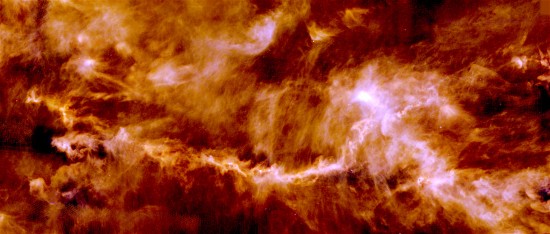
B211/B213 filament in the Taurus Molecular Cloud. Blue represents 160 microns wavelength, green is 250 microns and red is at 500 microns. Credit: ESA/Herschel/PACS, SPIRE/Gould Belt survey Key Programme/Palmeirim et al. 2013
May 31, 2016
Galaxies are threaded through with filaments.
The Herschel Space Observatory was launched with the largest spaceborne mirror ever constructed: 3.5 meters in diameter. Herschel was set to orbit around LaGrange point L2 in July 2009, to protect its liquid helium-cooled infrared detectors. However, Herschel’s helium coolant system was built to last only three years, so on April 29, 2013 its mission came to an end.
According to a recent press release, astronomers working with data provided by Herschel found evidence for electric circuits in space, although that is not how consensus astronomers label their observations. They identified “… an intricate pattern of filaments dotted with a few compact, bright cores: the seeds of future stars.”
Filaments of electric charge can flow in closed circuits through plasma. It is electric circuits in space that distinguishes Electric Universe theory from most conventional viewpoints. “Mysterious” phenomena are readily explained when observational evidence is coupled with laboratory experiments. That alone distinguishes Electric Universe concepts from others. Gravity-based theories are impossible to model in the laboratory.
As Philippe André, Principal Investigator for the Herschel Gould Belt Survey, wrote:
“The greatest surprise was the ubiquity of filaments in these nearby clouds and their intimate connection with star formation.”
It is those braided plasma filaments that confirm the existence of circuits in space. Celestial bodies are not isolated from one another but are connected across vast distances. Electric discharges in plasma create magnetic sheaths along their axes. High current discharges cause the sheathes to glow while creating other sheaths within. Double layers form when positive charges build up in one region and negative charges build up nearby. Electric fields develop between regions, which accelerates charged particles. Electric charges spiral in the magnetic fields, emitting X-rays, extreme ultraviolet, and sometimes gamma rays.
Electromagnetism “pinches” those channels, otherwise known as Birkeland currents, into filaments that tend to attract each other in pairs. Electric fields along the plasma strands generate electric forces that can be 39 orders of magnitude greater than gravity. However, when Birkeland currents approach each other, instead of merging, they twist into a helix that rotates faster as it compresses tighter. It is those “cosmic transmission lines” that make up galactic circuits.
The cosmos is laced with those interacting circuits, each of them composed of untold numbers of twisting Birkeland currents. There are power-consuming loads in those circuits converting electrical energy into rotational energy. They are known as galaxies. Galaxies exist within the filamentary circuit of electricity threading the cosmos like power lines through a city. They should be evaluated according to electrodynamic principles rather than mechanical behavior—with mysterious magnetic fields added to save the theory.
In an Electric Universe, large-scale plasma discharges form coherent filaments that exhibit electrodynamic behavior. Gravity and kinetic energy do contribute to the behavior of star clusters and galaxies but it is not their fundamental energy source. Stars in galaxies can form like silver beads on a string, lining-up for great distances.
When plasma moves through a cloud of dust and gas, some of the neutral molecules in the cloud are ionized, initiating electric fields, and thereby creating magnetic fields that tend to align and constrict the charge flow. Since Birkeland currents are electromagnetic, they isolate regions of opposite charge and prevent them from neutralizing. Planetary nebulae are spun from intricate webs of lighted tendrils. Herbig-Haro stars and energetic galaxies emit braided jets. Some galaxies look “hairy,” with threads of material extending from them.
Presumptions are hard to ignore. Conventional researchers do not understand several factors, which hampers their ability to grasp the fundamental nature of the cosmos. In particular, the adherence to redshift for cosmic distance measurements and a lack of knowledge when it comes to electricity.
Stephen Smith












